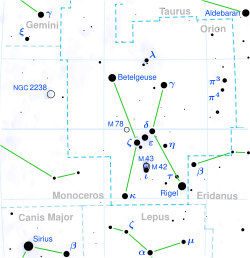Pi3 Orionis
| Observation data Epoch J2000.0 Equinox J2000.0 |
|
|---|---|
| Constellation | Orion |
| Right ascension | 04h 49m 50.41091s |
| Declination | +06° 57′ 40.5883″ |
| Apparent magnitude (V) | 3.16 |
| Characteristics | |
| Spectral type | F6 V |
| U−B color index | +0.00 |
| B−V color index | +0.46 |
| Variable type | Suspected |
| Astrometry | |
| Radial velocity (Rv) | 24.1 km/s |
| Proper motion (μ) |
RA: 464.06 mas/yr Dec.: 11.21 mas/yr |
| Parallax (π) | 123.94 ± 0.17mas |
| Distance | 26.32 ± 0.04 ly (8.07 ± 0.01 pc) |
| Absolute magnitude (MV) | 3.65 |
| Details | |
| Mass | 1.236 M☉ |
| Radius | 1.323 ± 0.004 R☉ |
| Luminosity | 2.822 ± 0.030 L☉ |
| Surface gravity (log g) | 4.4 cgs |
| Temperature | 6,516 ± 19 K |
| Metallicity [Fe/H] | 0.02 dex |
| Rotational velocity (v sin i) | 17 km/s |
| Age | 1.4 Gyr |
| Other designations | |
| Database references | |
| SIMBAD | data |
Pi3 Orionis (π3 Ori, π3 Orionis) is the Bayer designation for a star in the equatorial constellation of Orion. It has the traditional name of Tabit and the Flamsteed designation 1 Orionis. At an apparent visual magnitude of 3.16, it is readily visible to the naked eye. Pi3 Orionis is the brightest star in the lion's hide (or shield) that Orion is holding. The distance to this star, as measured using the parallax technique, is 26.32 light-years (8.07 parsecs). Though no extrasolar planets have been observed around Pi3 Orionis, the star is considered a prime location for planets as small as the Earth.
Pi3 Orionis is a main-sequence star of spectral type F6 V. Since 1943, the spectrum of this star has served as one of the stable anchor points by which other stars are classified. Compared to the Sun, it has about 124% of the mass, 132% of the radius, and nearly 3 times the luminosity. This energy is being radiated from the star's outer atmosphere at an effective temperature of 6,516 K, giving it the yellow-white glow of an F-type star. Pi3 Orionis is most likely single; a nearby star is probably an optical companion.
Although a periodicity of 73.26 days has been observed in the star's radial velocity, it seems likely to be bound more to stellar activity than to a planetary object in close orbit. No substellar companion has been detected so far around Pi3 Orionis and the McDonald Observatory team has set limits to the presence of one or more planets with masses between 0.84 and 46.7 Jupiter masses and average separations spanning between 0.05 and 5.2 astronomical units. Thus, so far it appears that an Earth-like planet could easily orbit the star without any complications caused by a gravitationally perturbing body.
...
Wikipedia

